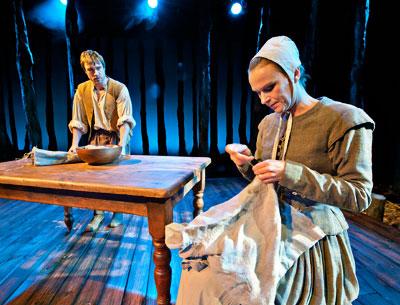Opinion: ‘The Crucible’: Blame Game

The Salem witch trials, portrayed in Arthur Miller’s “The Crucible,” currently at Bay Street Theatre through Nov. 24, show only one in a series of unfortunate periods in our history where mob mentality overcame common sense.
It may seem ridiculous to us now that a few young girls in a Massachusetts town could point the finger at others — others who had caused them real or imaginary offense — and send those people to the gallows for witchery. But it happened. And, in the grand scheme of things, not really that long ago.
Abigail Williams, dismissed from the Proctor household by Mrs. Proctor for having a tumble in the hay with Mr. Proctor, is found by her uncle, Reverend Paris, dancing in the woods with her friends at midnight. (What the good reverend was doing in the woods at midnight himself is perhaps another story.) Some of the girls have fallen ill (too much running around at night, perhaps), and to avoid trouble herself, Abigail tells her uncle that the Devil made them do it. And from there the trouble begins.
As additional people come to believe Abigail, she grows more powerful and vengeful, and more of the townsfolk are either identified as witches, forced to become “friendly witnesses,” or left to rot silently in jail, and the horrifying cycle continues.
This would be enough to make “The Crucible” the dramatic classic it is, but that’s not really what it’s about. Miller wrote the play as a response to the House of Un-American Activities Committee’s blacklisting of over 300 of the film and theater crowd during the early 1950s, including the famed “Hollywood Ten” and the playwright himself. During the Red Scare, which was fueled by the alcoholic ramblings of Senator “Tailgunner Joe” McCarthy, friends turned on friends, citizens were threatened for harboring communists or being them, and hysteria bloomed across the nation. Again, this really happened.
But back to Salem, 1692. Murphy Davis’s shortened version of “The Crucible” is part of Bay Street’s “Literature LIVE!” educational outreach program for middle and high school students and educators in the community, but it is open to the public. Mr. Davis explained before the show that in order to fall within the Board of Cooperative Educational Services guidelines, all “Literature LIVE!” performances must run 90 minutes or under, so cuts to the original production had to be made.
Gary Hygom’s set of stark trees doubles, with an assist from Mike Billings’s lighting, as prison bars, and a skirt of dead leaves around the stage adds to the barren feel. The cast is exemplary. Joanna Howard’s Abigail sends off those obsessive “Fatal Attraction” vibes whenever Rob DiSario’s John Proctor is around, and Mackenzie Engeldrum as Mercy and Kate O’Phalen as Mary Warren turn in wonderful performances as Abigail’s cohorts. Ms. O’Phalen in particular gives a moving turn as a young girl torn between going with the crowd and doing the right thing.
Kate Mueth plays Ann Putnam, who has lost seven babies, with just the right amount of crazy, a woman looking for a reason and finding one in the accusation of witchcraft. Lisa Cory — a descendent of Giles Cory, one of those found guilty in Salem three centuries ago — gives the audience a solid, no-nonsense Rebecca Nurse, and the three elders of the court, Ken Forman as Reverend Paris, Peter Connolly as Reverend Hale, and Joel Leffert as Deputy Governor Danforth, walk the line between hateful and human as the stakes are raised.
Mr. DiSario and Chloe Dirksen as the Proctors, who are trying to recover their marriage in the midst of mayhem, give inspired performances. It’s a superior production. A single quibble would be the editing out of Giles Cory, whose character adds levity to a very serious play. But all in all, the production is a very good one, and we are lucky to have a professional theater of Bay Street’s caliber in our midst.
The blame, the tension, the deceit and subterfuge exhibited in “The Crucible” reminds the audience that — in the words of George Santayana, who died during the H.U.A.C. hearings — “Those who cannot remember the past are doomed to repeat it.”
